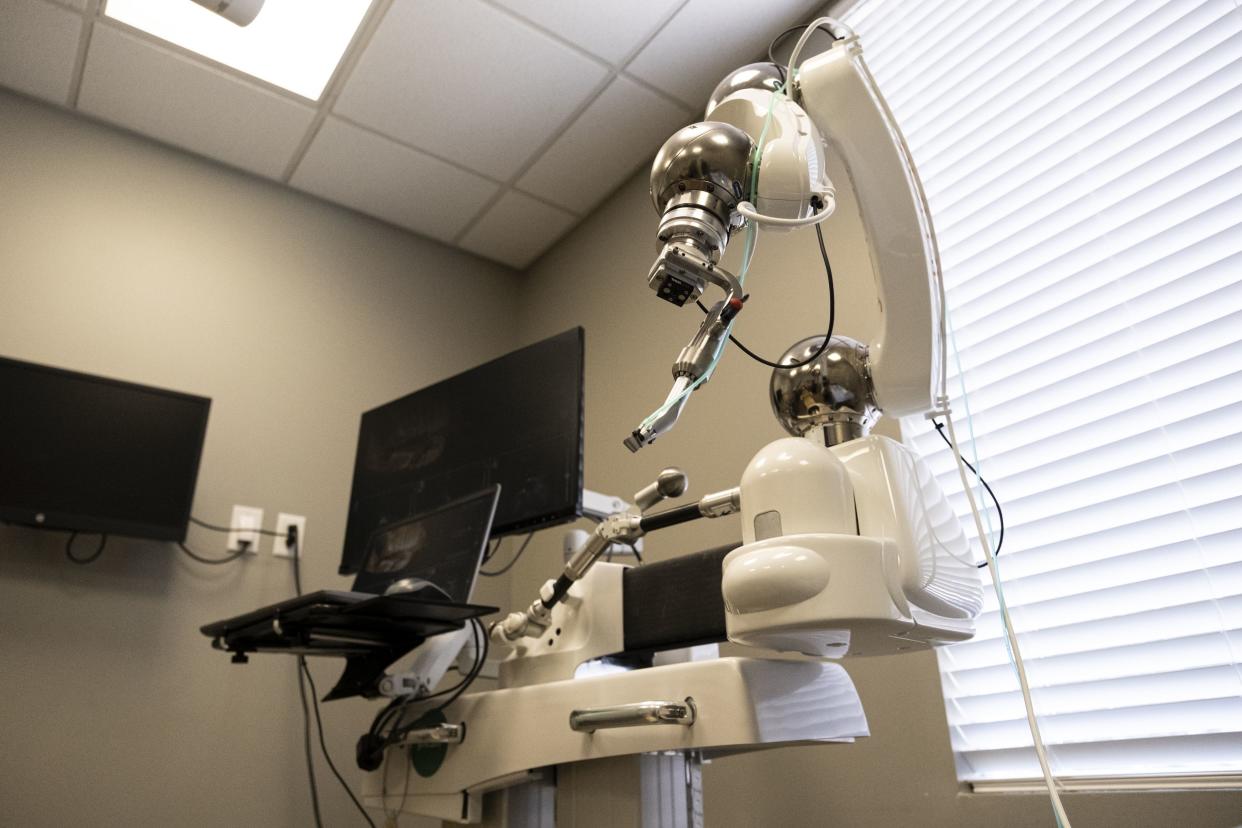The future of dentistry? Robot assists in procedures at Virginia Beach clinic


Virginia Beach Realtor Melissa Ly said she was excited to go to the dentist in June. Even though she’d had a dental implant, it was her first time for the procedure in which the doctor was assisted by a robot.
“I love technology,” she said.
The semi-autonomous robot, called YOMI from Miami-based Neocis Inc., is the first U.S. Food and Drug Administration-approved device to perform such procedures and remains the only such device approved for use. It operates similarly to a GPS system, according to Dr. Geoffrey Schreiber of Eastern Virginia Oral and Maxillofacial Surgery’s office in Virginia Beach, and Neocis.
The Virginia Beach dentistry clinic has been using the YOMI machine since 2019 and Schreiber said it has been a valuable tool that is well-liked by patients.
Good thing, because it appears to be part of the future of dentistry.
In the future, automation could also address a large, unmet need in dentistry — prosthetics and restoration, according to a May 2021 medical journal paper.
New technology for prosthetics and tooth restoration could help manufacture the dentures for roughly 113 million Americans who have at least one missing tooth and roughly 19 million Americans who have no teeth, according to the paper.
The global market for dental implants and the materials needed for after the surgery is expected to almost double to reach $9 billion over the next nine years while it was valued under $5 billion last year, according to a report published Thursday by Global Market Insights, a market research and consulting agency. The agency expects this growth as populations age in Europe and America and more people are born with dental disorders.
“The research on robots in prosthetic dentistry would be a breakthrough, as well as technical and theoretical innovation,” the paper said. “Its successful operation would not only accomplish the quantification of the partial or complete denture, however, also contribute to the progress of prosthetic dentistry.”
Today, the YOMI machine takes information from the scan of a patient’s mouth prior to the procedure and provides a visual model for the dental providers.
“Before we had this, we were doing implants with 3D printed guides, which are accurate, but you can’t change the plan, like you can in a YOMI, in the middle of a surgery,” Schreiber said.
This also helps dentists avoid any risk of nearing the nerve during an implant procedure, and it minimizes pain for the patient after the procedure, according to Schreiber.
“In the past, we used to make big incisions to see the bone where you’re placing the implant,” he said. “Now, we can essentially do it flapless — meaning we don’t have to lift a big gum tissue flap up and we can place the implants.”
The machine also keeps of track of a patient’s movements to ensure that the arm will adjust itself to always be in the right place, Schreiber demonstrated.
The arm, though, doesn’t move on its own despite its constant feedback and assistance to the doctor.
“We’re always in control,” Schreiber said. “It’s like a guiding hand.”
All this means sometimes in the same day, the dentists can remove a tooth, put in an implant and attach a crown compared with the traditional method that requires weeks or even months of waiting after tooth removal to ensure the socket has healed.
Though YOMI’s robots were the first to be approved by the Food and Drug Administration a few years ago, the basis for the technology dates to the mid-1980s, according to Robotics in Dental Implantology, a 2019 medical paper written by Chinese dental professionals.
The engineering was pioneered by NASA for use on astronauts while in space and soldiers on battlefields, according to the paper. After a robot for minimally invasive abdomen surgery was approved by the FDA in 2000, tech companies have developed machines to help perform various procedures in years since, according to the paper.
In 2017, a fully automated dental implant device was created in China and another similar machine was created the same year by the Fourth Military Medical University Hospital and Beijing University as a way to make sure soldiers were able to get dental care despite the shortage of trained medical staff, according to the 2021 paper.
Though YOMI’s machines can cost $160,000 to $200,000, the price for the procedure at Eastern Virginia Oral and Maxillofacial Surgery hasn’t changed because the practice is able to speed up dental visits with the technology and perform more procedures for more patients.
“The main benefit is to the patient,” Schrieber said.